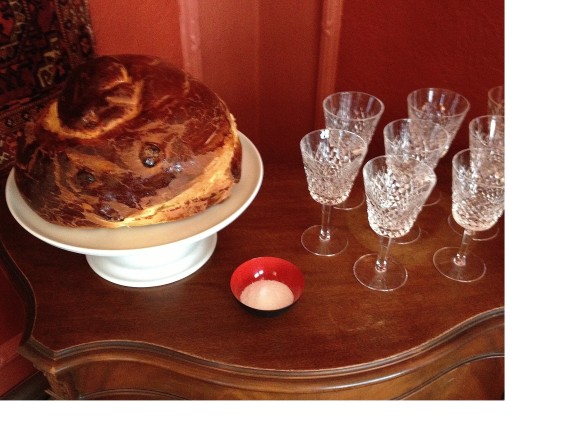
Dave, who was our bartender for the Hawaii edition of supperclub, doesn’t cut corners. This means getting original recipes, infusing his own mixers, and making his own mixers. And we wouldn’t have it any other way. For our Hawaii supperclub, Dave donned his best vintage aloha shirt and treated us to not one but two beautifully crafted South Pacific themed drinks for the occasion.
And what are cocktails without tall tales? This one happens to be true, but it’s hard to believe. Peter had been to Hawaii at least a few times before Linda’s first trip, which was in the summer of 1995. Linda had just finished her first year of medical school, and sometime in the winter of that first year, had casually looked for summer internship opportunities. One day, she read through the alumni notes section of her medical school magazine. There was a feature on someone who had graduated about 10 years prior and was working at the University of Hawaii and had done some research on lifestyle factors in heart disease. This was long before Linda realized that she would also one day get into the field of lifestyle medicine, but what caught her eye were the words “Honolulu, Hawaii.” Ever the enterprising student, Linda send a letter to the alumna, which read somewhere along the lines of:
“Dear Alumna,
I am a first year medical student at your alma mater. I read with interest about the research you have been conducting and am wondering if you could use a summer research assistant.
Sincerely,
Linda.”
Into the mail it went (pre-email!), with dim hopes for a response.
A few weeks later, Linda received an unbelievable response! It read:
“Dear Linda,
Thank you for your interest. I do not need a research assistant, but you are welcome to stay with me. I don’t have a guest room, but you can pitch a tent on the back deck.
Sincerely,
Incredibly Generous Alumna.”
Call it naivete, but Linda decided this was an opportunity she could not pass up. So she took some of her student loan living expenses and bought a roundtrip ticket to Honolulu. Peter thought it was a good idea, too, so he did the same.
Summer came along, and somehow, it still seemed a reasonable idea to fly all the way from Providence, Rhode Island to Honolulu with the only plan being to stay with a complete stranger in a strange land. Linda went alone, to be joined by Peter the next day. She was greeted at Honolulu airport by the very friendly alumna who welcomed her like a long-lost sister, and drove her to her home. There, she was also welcomed by the alumna’s boyfriend and her son, who was about 6. “This is my son,” she said. “Maybe you can babysit him one day.” Then she showed me a tent set up on the promised deck, which was along a canal. “That’s where you will be staying.” Finally, she handed Linda a ring of keys. “Here’s a key to my extra car– it’s kind of a clunker. And that’s the access key for the yacht club, in case you want to hang out there.”
So the next day, Linda drove in her borrowed car to the airport to pick up Peter, who couldn’t believe his eyes. They spent one happy week on one beautiful island, and only good things, like sunsets and beaches, happened.
Their host shared her story. Linda and Peter accepted it as truth, but in retrospect, it’s a bit hard to believe. Their host said that after completing medical school, she wasn’t sure what field of medicine she wanted to go into. So she pursued her other passion, sailing, and decided to crew yachts for people around the South Pacific. This is how she found herself on Tonga, the Polynesian island Kingdom. While she was there, a young member of the royal family had a seizure. She happened to be around, and using her very limited medical knowledge, helped stabilize the young boy. Once he was stable, she examined him, and saw that he had an ear infection. Thinking this might have been the cause of the seizure, she approximated a dose of penicillin for him from her own supplies, and he recovered. She was rewarded for her efforts by being given her first medical license (from the Kingdom of Tonga), and use of a house, a horse and houseboy for the summer. She named the horse “Ti’e Ti’e,” “stitches” in Tongan.

Skeptical? Don’t forget, Linda and Peter were told and believed this story at their impressionable young ages of their early 20s, and with perhaps more than an average amount of naivete. Would they allow their children to follow in their trusting footsteps? Of course not! Would they do it again? Maybe… But they are so very glad that they did, tall tales or true stories regardless.
And they lived happily ever after.
________________________________________
South Pacific
1/2 oz pineapple juice
1 oz passion fruit juice
Juice of 1/2 lime
1 oz citron vodka
1 oz lychee liqueur
Shaken, served in citrus-sugar rimmed cocktail glass.
Homage to Traditional Trader Vic’s Mai Tai
1 oz pineapple ginger infused rum agricole
1 oz Jamaican rum
1/2 oz orange curaçao
1/2 oz orgeat (preferably home-made)
Juice of one lime
Shaken, served in tiki mug over ice with mint sprig.
Thirsty for more? Come back next week for our starters! For a overview of our Hawaiian menu, visit the first post. Aloha!











